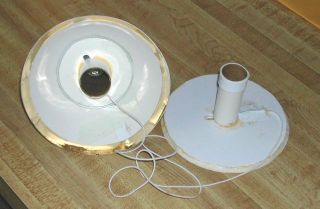Art Applewhite Rockets Cone Rocket 24mm
Art Applewhite Rockets - Cone Rocket 24mm {Kit}
Contributed by Dick Stafford
| Construction Rating: | starstarstarstarstar_border |
| Flight Rating: | starstarstarstarstar_border |
| Overall Rating: | starstarstarstarstar_border |
| Manufacturer: | Art Applewhite Rockets  |
Brief:
I have really been digging Art's saucers and now Art is branching out to other designs. As the name indicates, this rocket is a simple cone that flies on 24mm motors. This seems to be the next logical step after the Delta saucer design, which is sort of a hybrid between a classical saucer and a cone.

Construction:
Materials:
- Two sheets of cardstock for the shrouds
- One piece of foamboard for the nosecone base and bottom plate
- One 2.75in 24mm motor mount
- One 3in 29mm motor tube (this was a beta-test version, the 29mm tube has been replaced with Totally Tubular T-24+, which telescopes over the 24mm motor mount)
- A 36in thin tubular elastic shock cord
Tools and supplies required:
- Scissors
- X-Acto knife
- White glue (I used carpenters glue)
- 5-minute epoxy (brand is not important as on the 29mm and 38mm saucers)
- 150 grit sandpaper
The materials and assembly techniques are all similar to Art's saucers. The instructions are detailed with lots of photos.
You start by cutting out the cardstock nosecone shroud. This is double layered and you have to cut two launch rod holes with an X-Acto knife. The main issue here is you have to make sure these holes are aligned. During assembly, I slipped the end of a disposable chopstick through the holes until the glue began to set. The base of the nosecone is a foamboard disc. As with the Delta saucers, the edge is beveled so it mates nicely with the paper cone. The center of the disc is removed to accommodate the upper body tube along with a launch rod slot. The cone, disc, tube, and one end of the shock cord are then dry fit. To strengthen the cone and add some nose weight, you next fill the tip of the cone with 5-minute epoxy and mix it in-situ. Some is spread thinly over the inside of the cone and on the beveled edge of the foam disc. These components are all slipped together and set aside to dry. (Did I mention the launch rod holes must be aligned?)
The bottom disc is cut, beveled, and slotted just like the bottom of the nose cone. The center hole on this component holds the 24mm motor mount, which you glue in with white or carpenter's glue. I used the plastic bag that held the kit as a work surface, to make sure the tube was flush with the bottom disc and keep stray glue off the wife's table.
The shell of my saucer was on a second sheet of cardstock that in my case was mirror gold. A small seam strip is glued onto one end of the shroud. Make sure you measure its position properly and have the pointed edge inward. The shroud is then wrapped onto the other half of the seam strip. I found this step a bit difficult, but I am all thumbs. The epoxy-reinforced nosecone was a great help in forming this outer shroud. There are two reinforcing strips on the same sheet of colored cardstock and these are glued to the bottom inside of the shell.
At this point the nosecone is glued into the shell. And as before, make sure the launch rod slots all line up. I'd give this a yadda, yadda, yadda, but, this potentially the biggest D'OH in the assembly of the kit. BTW this warning strategically located in bold throughout the instructions.
 The final step is attaching the other end of the shock cord to the bottom assembly with a 3-fold paper mount. The shock cord is slipped between the two sections, and the bottom is slipped into the nose cone section, which is now basically the entire shroud.
The final step is attaching the other end of the shock cord to the bottom assembly with a 3-fold paper mount. The shock cord is slipped between the two sections, and the bottom is slipped into the nose cone section, which is now basically the entire shroud.
Finishing:
No finishing is required on the mirror gold saucers, but the printed ones should have at least 2 - 3 coats of clear enamel to protect them from moisture. Since we are in an outdoor hobby, there is a good chance it will drizzle on your saucer. Been there done that.
Some observations on the mirror gold cardstock: First, it really does look great. It is also forgiving with glue smudges, as you can wash it off with a moist paper towel. This is good because I got a lot of glue around the seam. However, I found it harder to form into a cone than plain cardstock, probably because of its stiffness.
Construction Rating: 4 out of 5
Flight:
The recommended motors include the C11-3, D12-3, E9-4, and any Aerotech 24mm SU or RMS. The motor is held in with masking tape and the rest of the prep is sliding it together with the shock cord out of the way of the launch rod holes. No wadding is needed.
I flew my cone rocket on a D12-5 and then on an E9-4. The D12 flight was quick and straight in light gusty winds. Ejection was very late, but this wasn't an issue. The E9 flight was long, high, and smoky, with some weathercocking. This is a great motor for this small cone.
Recovery:
After ejection, the saucer falls nose section first with the motor tube end following behind. This plate dangling behind the cone does a good job making up for the somewhat heavy epoxy-filled tip. There was no damage on either flight, with the nose sticking in the soft, moist dirt. I didn't have the recommended stand-off distance (6in) from the pad, so my foamboard had a few small holes burned into it. I merely filled them with blobs of white glue. More importantly though, the thin elastic cord has started to break through and will have to be replaced. The ejection charges on the SU motors were quite energetic for the short tube and in both cases, the motors were spit out. If this is a concern on your field, make sure you use plenty of tape to hold it in very tightly (this may also save your RMS casing).
Flight Rating: 4 out of 5
Summary:
This is another winner for Art. The cone is an easy build, flies great and is a lot of fun! I love that mirror gold paper too. The one negative I found is the thin elastic shock cord. I will most likely replace it with a piece of Pratt Hobbies' new Kevlar® micro braid.
Overall Rating: 4 out of 5
Other Reviews
- Art Applewhite Rockets Cone Rocket 24mm By David Urbanek
Brief: It's an unusual cone rocket. No fins, but the nose weight makes it stable. Pre-printed paper cone, so you don't need to paint it. Very simple to prep. Construction: You have to be ready and willing to roll cones out of light cardstock. There is also a short piece of nesting body tubes, and some foam board for the base and mid-section bulkhead. If you're not used to ...
- Art Applewhite Rockets Cone Rocket 24mm By Bob Cox
Diameter: 5.5 inches (14cm) Height: 4.75 inches (12 cm) Weight: 1.3 oz (35 gm) Finish: I built the Mirror Gold version. Other patterns available include Stars and Stripes, Texas Special, Silver, Fluorescent Orange, Fluorescent Yellow, Fluorescent Green, Hot Pink, and plain White. CONSTRUCTION: Parts: All parts are packaged in a heat-sealed clear plastic bag with no ...
- Art Applewhite Rockets Cone Rocket 24mm By Dave Stout
Brief: The Art Applewhite Cone rocket is a single stage, cone stabilized rocket. Construction: Art's rockets are amazing. They are comprised of a small number of lightweight parts. This kit comes with a 1/4" foamcore board with printed patterns, a piece of gold mirror cardstock with patterns printed on the back, a piece of plain cardstock with parts printed on it, two nice ...
 |
 |
Flights
Sponsored Ads
 |
 |




![Calling Marshall Applewhite [Explicit] Calling Marshall Applewhite [Explicit]](https://m.media-amazon.com/images/I/51MeUaBWTkL._SL500_.jpg)





